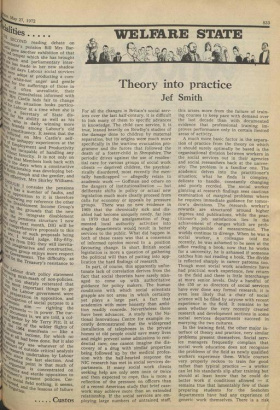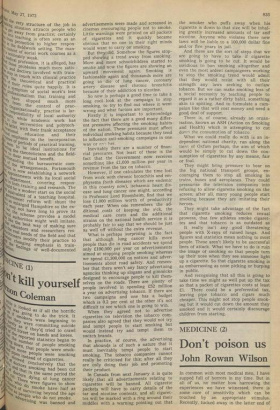Theory into practice
„Id Smith
For all the changes in Britain's social services over the last half-century, it is difficult to link many of them to specific advances in knowledge. The child care service, it is true, leaned heavily on Bowlby's studies of the damage done to children by maternal separation, but its origins were much more specifically in the wartime evacuation programme and the furore that followed the death of a foster-child in Shropshire. The periodic drives against the use of residential care for various groups of social work clients — deprived children, the psychiatrically disordered, most recently the mentally handicapped — allegedly relate to academic work — Goffman and others on the dangers of institutionalisation — but deliberate shifts in policy or actual new legislation much more clearly proceed from calls for economy or appeals by pressure groups. There was no new evidence in 1969 that the chronically sick and disabled had become uniquely needy, far less in 1970 that the amalgamation of fragmented local authority activities into single departments would result in better services to the public. What did happen in both of these cases was that a consensus of informed opinion moved to a position favouring change. In short British social legislation is more a question of gathering the political will than of putting into application the hard findings of research.
In part, of course, this apparently unfortunate lack of correlation derives from the fact that social theorists have rarely managed to come up with authoritative guidance for policy makers. The human conditions with which social scientists grapple are not areas in which certainty yet plays a large part, a fact that academics with more honesty than ambition readily concede. Nevertheless there have been advances. A study by the National Innovations Centre for example recently demonstrated that the widespread installation of telephones in the private homes of old people could save many lives and might prevent some admissions to residential care; one cannot imagine the discovery of a drug with similar properties being followed up by the medical profession with the half-hearted response the NIC research has met in social services departments. If many social work clients seeking help are only seen once or twice and then expected to cope, this is more a reflection of the pressure on officers than of a recent American study that brief casework may achieve more than an extended relationship. If the social services are employing large numbers of untrained staff, this arises more from the failure of training courses to keep pace with demand over the last decade than with documented evidence that professional training improves performance only in certain limited areas of activity.
A much more basic factor in the separation of practice from the theory on which it should surely optimally be based is the organisational division between workers in the social services out in their agencies and social researchers back at the university. The problem is a familiar one. The academic delves into the practitioner's situation; what he finds is complex, delicate to handle, constantly changing and poorly recrded. The social worker glancing at research findings sees cautious examination of marginal problems where he requires immediate guidance for tomorrow's decisions. The research worker's rewards are structured around higher degrees and publications, while the practitioner's job satisfaction lies in the achievement of changes which are probably impossible of measurement. The worlds continue to diverge. When he was a social worker, a colleague told me recently, he was ashamed to be seen at the office reading a book; now that he works for a university, he is ashamed if someone catches him not reading a book. The divide is reflected sharply in career patterns too. Though most social work academics have had practical work experience, few return to the field and there is little interchange at more senior levels. Only a handful of the 150 or so directors of social services have ever done any formal research; it is even less likely that a chair of social science will be filled by anyone with recent experience in the field. It remains to be seen whether the very recently created research and development sections in some social services departments succeed in marrying the two cultures.
In the training field, the other major interface of theory and practice, very similar problems present themselves. Social service managers frequently complain that social work education does not recognise the problems of the field as newly qualified workers experience them. While courses very properly reckon to train for good rather than typical practice — a worker can let his standards slip after training but should at least know that he could do better work if conditions allowed — it remains true that lamentably few of those preparing students for the Seebohm departments have had any experience of generic work themselves. There is a risk the very structure of the job in situation attracts people who .e-Pt sway from practice; certainly f'at0 teaching is often seen as an .y ;rare' Promotion to higher respon i'a the fieldwork setting. The manronte
iis „ of social work courses as a ''"Iiceably weak.
,ecitnetcl,ical profession, it is alleged, has nese problems much more satisN"'' and doctors involved with train 1:ey in touch with clinical practice the theoretical and practical 14 their roles quite happilyIt is 4 sYMptom of social work's less Pr'gessionalisrn that training and
leek have slipped much more
()front the control of practhe 57"ganisationally, practise is larrge;,e8Ponsibility of local authority while academic work has .1V, the universities and Polytech v, latter, With their frank acceptance :1104tationa1
education and their titat1;4nPhasis on the incorporation
periods of practical training, ftlitit;:n,., to be ideal institutions for k'ts t° `he theoreticians and the field40 the. 4itlist, 1r Mutual benefit. of 4,114:ling the bureaucratic corn'44;„t,"e arrangements, Portsmouth '8flow establishing a network Inintrnents with its local social ;24ePartment, covering responusQnth training and research. The 'tts eahh, e a modest start on the social ach,'"Ivalent of a teaching hospital. 4it er ,11'nent reform will shunt the enlarged Hampshire so the ex,I)titIllaY not have long to prove its ,1441 the scheme provides a model h lot atIthorities might well imitate. pedthe best way of making sure ,t°th,'Ilcators and researchers res44etit-i„real needs of the field and that rat'''ners modify their practice to kd the ch,anging emphasis in train,/ lkatioti. 'ridings of well-documented











































 Previous page
Previous page